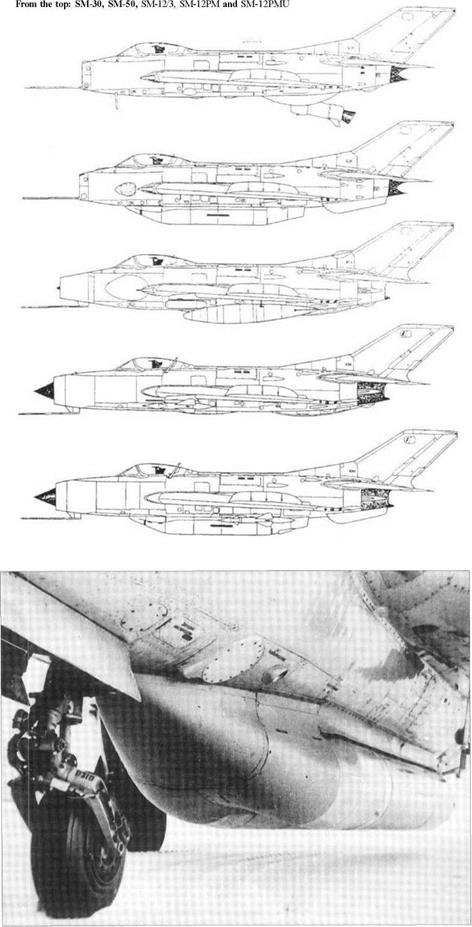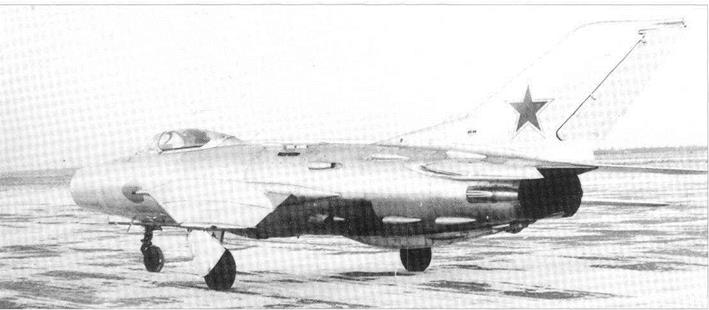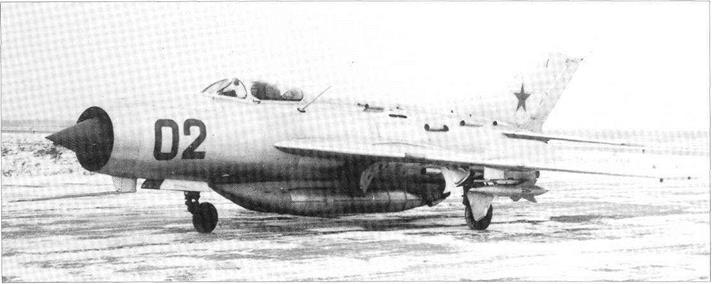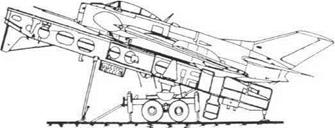SM-50
This designation applied to the MiG-19 fitted with a booster rocket engine in a pod underneath. Whereas previous mixed-power fighters had been primarily to test the rocket, the SM-50 was intended as a fast-climbing fighter, able very quickly to intercept high-flying bombers. The first SM-50 was a MJG-19S fitted with a removable ventral pack called a U-19 (from Uskoritel’, accelerator). Made at the MiG OKB, this was basically formed from two tubes arranged side-by-side with a nose fairing. It contained an RU-013 engine from L S Dushkin’s KB, fed by turbopumps with AK-20 kerosene and high-test hydrogen peroxide. The pilot could select either of two thrusts, which at sea level were 1,300kg (2,866Ib) or 3,000kg (6,614Ib). To avoid the rocket flame the aircraft’s ventral fin was replaced by two vertical strake-fins under the engines (which were RD-9BM turbojets with variable afterburning thrust but unchanged maximum rating). The first SM-50 began factory testing (incidentally after the Ye-50, and long after the first MiG-21 prototypes) in December 1957. Despite a take-off weight of 9,000kg (19,841 Ib) a height of 20,000m (65,617ft) was reached in under eight minutes with the rocket fired near the top of the climb, boosting speed to l,800km/h (1,118mph, Mach 1.695). Dynamic zoom ceiling was estimated at 24,000m (78,740ft). Five pre-production SM-50s were built at Gor’kiy, but they were used only for research.

 SM-12
SM-12
Early in the production of the MiG-19 it was realised that the plain nose inlet was aerodynamically inefficient at supersonic speeds, and that a properly designed supersonic inlet would enable maximum speed to be significantly increased without any change to the engines. By the mid-1950s the OKB was well advanced with the prototypes that led to the MiG-21 and other types, all ofwhich had inlets designed for supersonic flight. In fact production of the MiG-19 in the Soviet Union was quite brief – it was left to other countries to discover what a superb fighter it was – and all had the original inlet. A total of four SM-12 (plus two derived) aircraft were built, with the nose extended to terminate in a sharplipped inlet. As in standard MiG-19s, across the inlet was a vertical splitter to divide the airflow on each side of the cockpit. This was used to support a conical centrebody whose function was to generate a conical shockwave at supersonic speeds. For peak pressure recovery, to keep the shock cone focussed on the lip of the inlet the cone could be translated (moved in or out) by a hydraulic ram driven by a subsystem sensitive to Mach number. A similar system has been used on all subsequent MiG fighters, though the latest types have rectangular lateral inlets. SM-12/1 was powered by two RD-9BF-2 engines with a maximum rating of 3,300kg (7,275 Ib). SM – 12/2, /3 and /4 were powered by the R3-26, with a maximum rating of 3,800kg (8,377 Ib). All four SM-12 aircraft were fitted with improved flight control systems, wing guns only and new airbrakes moved to the tail end of the fuselage. A fifth aircraft, designated SM-12PM, was fitted withpylons fortwo K-5M guided missiles, which were coming into production as the RS-2U. This required a guidance beam provided by an RP-21 (TsD-30) interception radar. The scanner necessitated a greatly enlarged nosecone, which in turn demanded a redesigned forward fuselage with hardly any taper. Both guns were removed, and there were many other modifications. The sixth and final version was the SM-12PMU, armed with two or four RS-2U missiles. This aircraft was intended to intercept high-altitude bombers faster than any other aircraft, so it combined two R3-26 engines with the U-19D rocket package. Numerous MiG-19 variants served as armament test-beds, mainly for guided missiles.

|














